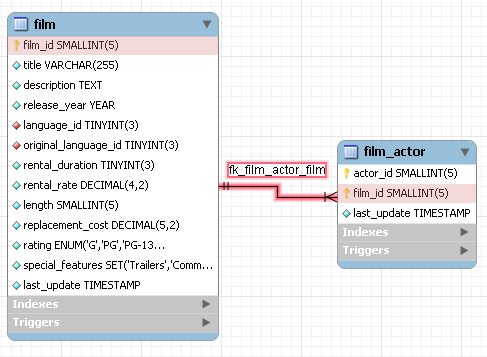- 7.5.2 Creating Foreign Key Relationships
- 7.5.2.1 Adding Foreign Key Relationships Using an EER Diagram
- 7.5.2.2 The Relationship Editor
- 7.5.2.3 The Properties of a Connection
There are five foreign key tools on the vertical toolbar on the left side of an EER Diagram. These tools are:
The
one-to-many non-identifying relationshiptoolThe
one-to-one non-identifying relationshiptoolThe
one-to-many identifying relationshiptoolThe
one-to-one identifying relationshiptoolThe
many-to-many relationshiptool
An identifying relationship is one where the child table cannot be uniquely identified without its parent. Typically this occurs where an intermediary table is created to resolve a many-to-many relationship. In such cases, the primary key is usually a composite key made up of the primary keys from the two original tables. An identifying relationship is indicated by a solid line between the tables and a nonidentifying relationship is indicated by a broken line.
Create or drag and drop the tables that you wish to connect. Ensure that there is a primary key in the table that will be on the “one” side of the relationship. Click on the appropriate tool for the type of relationship you wish to create. If you are creating a one-to-many relationship first click on the table that is on the “many” side of the relationship and then on the table containing the referenced key.
Doing this creates a field in the table on the many side of the
relationship. The default name of this field is
table_name_key_name where the table
name and the key name are both derived from the table containing
the referenced key.
When the many-to-many tool is active, double clicking a table creates an associative table with a many-to-many relationship. For this tool to function there must be a primary key defined in the initial table.
Use the Model, Menu Options menu item to set a project-specific default name for the foreign key column (see Section 7.1.5.4, “The Relationship Notation Menu Option”). To change the global default see Section 5.4.4, “The Model Tab”.
To edit the properties of a foreign key double click anywhere on the connection line that joins the two tables. Doing this opens the relationship editor.
Mousing over a relationship connector highlights the connector and the related keys as shown in the following figure.
The film and the film_actor
tables are related on the film_id field and
these fields are highlighted in both tables. Since the
film_id field is part of the primary key in the
film_actor table, a solid line is used for the
connector between the two tables.
If the placement of a connection's caption is not suitable, you
can change its position by dragging it to a different location. If
you have set a secondary caption, its position can also be
changed. (For more information about secondary captions see
Section 7.5.2.3, “The Properties of a Connection”. Where the notation
style allows, Classic for instance, the
cardinality indicators can also be repositioned.
The relationship notation style in Figure 7.11, “The Relationship Connector” is the default, crow's foot. If you are using a commercial version of MySQL Workbench you can change this. For more information, see Section 7.1.5.4, “The Relationship Notation Menu Option”.
You can select multiple connections by holding down the Ctrl key as you click on a connection. This can be useful for highlighting specific relationships on an EER diagram.

